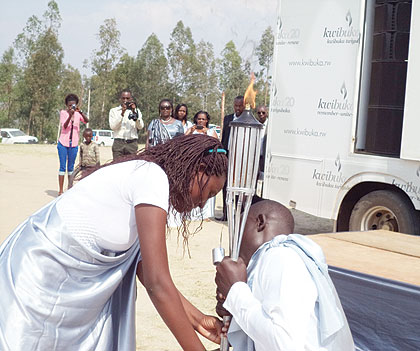A genocide does not just happen. It requires systematic planning. It requires action geared towards extermination. In April 1994, what happened was the culmination of years of indoctrinating minds with discriminatory ideology, of denigrating the Tutsi, and encouraging a culture of impunity, when it came to killing the Tutsi.


A genocide does not just happen. It requires systematic planning. It requires action geared towards extermination. In April 1994, what happened was the culmination of years of indoctrinating minds with discriminatory ideology, of denigrating the Tutsi, and encouraging a culture of impunity, when it came to killing the Tutsi. Yet, as the years go by, the horrors of 1994, 1973, 1963-4 and 1959 seem to fade away. And those who wish to make the world forget are working hard to achieve their desire. The Telegraph recently published a study by Holocaust Memorial Day Trust that found that half of Britons over 16 years could not name a single act of genocide after the Nazi Holocaust. We must make sure the world does not forget horrors of genocide. The Genocide against the Tutsi must not be forgotten. Paying a deaf earOn January 19, 1994, Prime Minister Agathe Uwilingiyimana wrote to the ministers of MRND (the ruling party) accusing the Minister of Defence Augustine Bizimana (still on the run), of refusing to implement a cabinet resolution calling for the disarmament of civilians who were in possession of arms illegally.Little did Uwilingiyimana know that the plan to distribute weapons, mainly guns, bullets and grenades to citizens was a move orchestrated by the MRND government to which she lodged her complaint.They must have read the letter and laughed. To them, a woman preaching unity when the real plan was genocide was a fool.Uwilingiyimana posed a threat to Hutu power ideology. She had years before, while serving as Minister of Education, abolished the quota system that limited the number of Tutsi joining secondary schools and universities. The removal of this restriction gave many Tutsi parents hope that their children would attain education that they had hitherto been denied.A short lived victory; the army (FAR) continued to order for arms and amunition and distributing them to civilians.According to Lt. Marc Nees, from Belgian military intelligence, on November 5, 1993, President Juvenal Habyarimana chaired a meeting where it was decided that arms be distributed for a specific purpose of finishing off the "Tutsi problem.” In the meeting, a decision was taken to arm the "Interahamwe” and the "Impuzamugambi” with grenades and machetes in order to kill the Tutsis, starting from Kigali.This was just one among many meetings that aimed at implementing what had already been agreed upon by the army in October 1993. The plan was set. The perpetrators were to execute their mission under the pretext of what they called "Kwirwanaho” or defending themselves.President Habyarimana announced in 1991 that lasting peace would only come after the Tutsi were exterminated.The rehearsal that became realOn January 20, 1994, a dress rehearsal was performed. Minister Justin Mugenzi, President of PL-Power, was to be killed. This was done to demonstrate that the genocidaires could eliminate whoever they wanted with impunity. Mugenzi later became part of the genocidal government. On the same day, Belgian ambassador to the United Nations told his Foreign Affairs Ministry that he had met with Iqbal Riza, deputy to Koffi Annan, who was then head of UN peacekeeping operations, to whom he had expressed concern about the security of the Belgians in Unamir (UN Mission in Rwanda).Riza is the official in New York who received the fax from Lt. Gen. Romeo Dallaire on January 11, 1994, warning of a possible plan to commit genocide in Rwanda and what could be done to prevent the mass slaughter.During the meeting, Riza explained to the Belgian ambassador the difficulties of implementing the Arusha peace agreement because Habyarimana and his Interahamwe militia had already started distributing weapons to civilians.A peace deal had been signed in Arusha in August 1993, but in reality, genocide was the only viable solution in the eyes of the sitting government. Those who lived in Kigali at the time remember the frequent grenades hurled at Tutsi homes that would kill or maim without anybody being punished. That culture of impunity sent a chilling message. The plan was clear: Kill a few Tutsi and no one will care, as we prepare to kill more, in the shortest time possible. "We need to defend ourselves against the enemy,” they often repeated. The enemy they were talking about were innocent, unarmed, trying hard to stay under the radar Tutsi men, women and children. The Genocide did not start in 1994. The plot was hatched many years before when killing a few Tutsi was rewarded. To them, a dead Tutsi wasn’t a tragedy. It was a stepping stone to influence. Tom Ndahiro is a genocide scholar. Read his work at umuvugizi.wordpress.com or friendsofevil.wordpress.com


